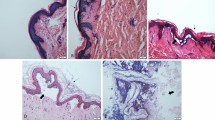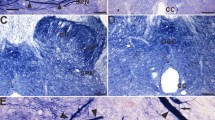Abstract
THE communication by Njaa et al.1 concerning the presence of ‘ringtail’ in newborn rats has prompted us to report similar observations in the colony maintained at these Laboratories. During the winter of 1954–55 signs of ‘ringtail’ were noticed in many suckling rats. Generally, these symptoms were seen in 8-day-old young rats, the first signs being a marked scaliness of the tail and reddening of the tail tip (Fig. 1). In many cases the condition of the tail deteriorated, resulting in necrosis followed by its severance from the body. Microscopic examination of sections of the tails revealed in the early stages a marked hyperkeratosis and parakeratosis (Fig. 2). There was œdema (spongiosis) and hyperplasia of the prickle cell layer, resulting in acanthosis. In some of the specimens, the prickle cells at all levels contained large amounts of keratohyaline granules. The hair follicles were slightly dilated and were filled with keratinized invaginations of the cornified layers of the epidermis. The corium was œdematous and often congested with blood. In the more advanced lesions, there was extensive eosinophilic necrosis of both the epidermis and the corium, accompanied by leucocytic infiltration. In general, these histological characters closely resemble those observed in the ring tails of rats born to mothers deprived of essential fatty acids2.
This is a preview of subscription content, access via your institution
Access options
Subscribe to this journal
Receive 51 print issues and online access
$199.00 per year
only $3.90 per issue
Buy this article
- Purchase on Springer Link
- Instant access to full article PDF
Prices may be subject to local taxes which are calculated during checkout
Similar content being viewed by others
References
Njaa, L. R., Utne, F., and Braekkan, O. R., Nature, 180, 290 (1957).
Guggenheim, M., and Jurgens, R., Helv. Physiol. et Pharmacol. Acta., 2, 417 (1944), quoted from Holman, R. T., in “Vitamins”, Vol. 2, edit. by Sebrell and Harris, 293 (Acad. Press, Inc., New York, 1954).
Hubbell, R. B., J. Nutr., 53, 429 (1954). Dikshit, P. K., and Taskar. A. D., Proc. Soc. Exp. Biol. Med., 93, 235 (1956).
Burr, G. O., Fed. Proc., 1, 224 (1942).
Author information
Authors and Affiliations
Rights and permissions
About this article
Cite this article
DIKSHIT, P., SRIRAMACHARI, S. Caudal Necrosis in Suckling Rats. Nature 181, 63–64 (1958). https://doi.org/10.1038/181063a0
Issue Date:
DOI: https://doi.org/10.1038/181063a0
Comments
By submitting a comment you agree to abide by our Terms and Community Guidelines. If you find something abusive or that does not comply with our terms or guidelines please flag it as inappropriate.



